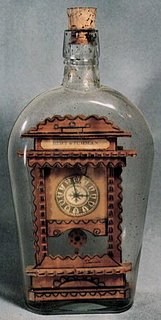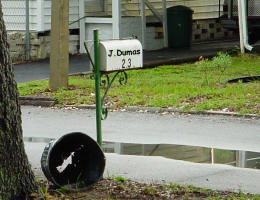
From Snopes:Claim: The face of the CPR training mannequin was modeled after the deceased daughter of a Swedish doctor who invented it.Status: False. While there are many CPR dummies or mannequins on the market, the face of the one most widely used was modeled on that of an anonymous young woman whose body was fished from the Seine around the turn of the 20th century. It was believed she had taken her own life, but since she was never identified, no details of her life were known and the events leading to her demise remain a mystery.In 1958, Asmund Laerdal of Stavanger, Norway, a doll and toy maker by trade, began work on a life-like manikin for training people on mouth to mouth resuscitation. Inspired by the mask of the young girl who died so young, he commissioned the well-known sculptress Emma Mathiassen to model a manikin face in her likeness. Thus, the spirit of the Girl from the River Seine again came to life as Resusci Annie in 1960.
Monday, January 22, 2007
The Story Behind CPR Annie
Posted by alilbit at 11:32 PM 0 comments
Tons Of Places To Visit



I live in Anchorage, Alaska and the photos are from downtown. I live on the east side. **43 PLACES.*****Wherever your travels take you it's great to check in with people who've been or are going there. 43 Places is the ultimate place to share stories about the corner joint and destinations across the globe. Research travel destinations, build your own personal travel map and tell friends across the world about your favorite local spots. If getting there is half the fun, 43 Places is your kind of party.Click 'I Want To Go Here' and begin a list of the 43 Places you'd like to visit. Share your local destinations with people around the globe.
Posted by alilbit at 11:02 PM 0 comments
Mexican Hat Dance

how to do the mexican hat dance***********More than just the dance here! Many fun activities too- A great family site.
Posted by alilbit at 12:09 AM 0 comments
Friday, January 19, 2007
Jungle Girl Found

'Wild Cambodia jungle-girl' found
A Cambodian girl who disappeared aged eight has been found after living wild in the jungle for 19 years, police say. The girl is believed to be Rochom P'ngieng, who disappeared while tending buffalo on the edge of the jungle in remote northern Rattanakiri province. Her father says he has identified her through scars and will have DNA tests taken to prove she is his daughter. Local police said the woman was "half-human and half-animal" and could not speak any intelligible language.
Posted by alilbit at 3:32 PM 0 comments
Wednesday, January 17, 2007
How Things Are Made- Videos


Via-Slackdaddy I find these fascinating.How It's Made - GuitarsHow It's Made - SnowboardsHow It's Made - AirplanesHow It's Made - Ice SculpturesHow It's Made - BathtubsHow It's Made - PaversHow It's Made - PianosHow It's Made - Strong AlcoholHow It's Made - CheeseHow It's Made - Contact Lenses
Posted by alilbit at 10:15 PM 0 comments
Sunday, January 14, 2007
Winchester House

The Winchester Mystery House is a California mansion that was under construction continuously for 38 years and is reputed to be haunted.It once was the personal residence of Sarah Winchester-Pardee, the widow of gun magnate William Winchester, but is now a tourist attraction. Under Sarah Winchester's guidance, construction on the house continued 24 hours a day, seven days a week, 365 days a year, until her death on September 5, 1922.Nobody is really sure how many rooms are in the Winchester Mystery House. Each new count seems to come up with a different number. It is estimated, however, that there are around 160 rooms.
Posted by alilbit at 4:07 AM 0 comments
Saturday, January 13, 2007
Random Facts


There are 11 points on the collar around Kermit the Frog's neck.
The word 'dude' was coined by Oscar Wilde and his friends It is a combination of the words 'duds' and 'attitude'
Olives are fruits
Gatorade was named for the University of Florida Gators where it was first developed.
The nutritional value of squash and pumpkin seeds improves with age. These seeds are among the few foods that increase in nutritional value as they decompose
The river Danube empties into the Black Sea.
Chicago's Lincoln Park was created in 1864. The original 120 acre cemetery had most of its graves removed and was expanded to more than 1000 acres for recreational use.
It takes a fall of about eight building stories to kill a cat A fall of three stories will typically break their jaw (due to a floating collar bone), but it takes a fall of five or six stories to break a leg
Cats have over one hundred vocal sounds, while dogs only have about ten.
You are likely to blink 415 million times during your lifetime
Posted by alilbit at 5:06 PM 0 comments
Friday, January 12, 2007
Folk In A Bottle

Folk Art in Bottles
Most people, even if they do not collect antiques or have any interest in folk art, have heard of "ships in bottles," have marvelled at the ingenuity of the carvers and wondered at the process of building the ship through the narrow neck of a bottle. Few people, however, realize that there are other forms of folk art in bottles, forms which are widely repeated and which have many common features.Other subjects carved and fitted into bottles include bar scenes, chairs, framed photographs and tintypes, birds, fans, tools, yarn winders and niddy-noddies, wishing wells, and crucifixions. Often called "whimsy bottles" because they were made for no apparent purpose other than for the fun and challenge, they clearly have their roots in German and Slavic folk art tradition. This tradition is known to go back at least into the early eighteenth century.This series of pages deals with the kind of folk art sculpture which was assembled inside of glass bottles. You'll find articles, history, and LOTS of pictures here.Folk Art in Bottles by S.D. Jones
Posted by alilbit at 4:28 PM 0 comments
Thursday, January 11, 2007
Boy Is Overjoyed With His Own Mailbox

An eight-year-old boy has got his own postbox because he loves sending letters.
Gareth Scott, who is autistic, now has his own postbox in his garden in Gatley, Greater Manchester.
His mum Denise wrote to Royal Mail to see if they'd supply a box. They couldn't but put her in touch with company Romec.
Company boss Paul Carr was so touched by Gareth story he sent a weighted fibreglass box and postman's hat to Gareth for free.
According to the Sun, Denise said: "He's over the moon."
Posted by alilbit at 6:23 PM 0 comments
Cool Motorcycles
 MOTORCYCLES OF THE 20TH CENTURY***A collection of more then 700 high quality motorcycle pictures.
MOTORCYCLES OF THE 20TH CENTURY***A collection of more then 700 high quality motorcycle pictures.
Posted by alilbit at 2:33 AM 0 comments
Sunday, January 07, 2007
Diet Pills For Fido

WASHINGTON (AP) - Is your hound round? Too much flab on your Lab? Is your husky, well, husky? A new drug may provide some help.
The government approved the first drug for obese canines on Friday. Called Slentrol, the Pfizer Inc. (PFE) drug is aimed at helping fat Fidos shed extra pounds.
"This is a welcome addition to animal therapies, because dog obesity appears to be increasing," said Stephen Sundlof, director of the Center for Veterinary Medicine at the Food and Drug Administration.
A dog that weighs 20 percent more than its ideal weight is considered obese. That takes in about 5 percent of the nearly 62 million dogs in the United States. An additional 20 percent to 30 percent are considered overweight.
The liquid drug appears to reduce the amount of fat a dog can absorb. It also seems to trigger a feeling of satiety or fullness, according to the FDA.
The prescription drug also can produce some unfortunate side effects, including loose stools, diarrhea, vomiting, lethargy and loss of appetite.
And it's not for dog owners. The FDA discourages the drug's use in humans and lists a litany of side effects should anyone ignore that advice. Nor is Slentrol, also called dirlotapide, for use in cats.
In general, dogs need a far fattier diet than humans do to thrive. Fat is an essential source of calories for dogs and is necessary for growth, development, reproduction and healthy skin, according to the American Veterinary Medical Association.
Like all diet drugs, Slentrol is meant to be part of an overall weight management program that includes a complete and balanced diet and exercise, according to its label. Slentrol is not a cure for obesity; its effects cease within a day or two of stopping treatment.
---
On the Net:
Food and Drug Administration: http://www.fda.gov/
Posted by alilbit at 5:18 PM 0 comments
Saturday, January 06, 2007
Atlantis Revealed

The fabled "Lost City" of Atlantis is one of mankind's greatest and most enduring mysteries. First written of 2,350 years ago by the Greek philosopher Plato in his works the Timaeus and the Critias, the island beneath the sea has fascinated historians, poets, and the public ever since, but has remained tantalisingly hidden, shrouded in myth, legend and exaggeration.
However, a new book by acclaimed historian Andrew Collins provides for the first time a clear argument for the civilisation's existence and a pointer to its location.
Plato described Atlantis as an empire founded by the sea god Poseidon on a land mass the size of "Libya and Asia put together". It possessed a thriving capital, with sumptuous palaces, royal courts and harbours constantly receiving vessels from all over the world. For many generations, it ruled the Atlantic Ocean as well as parts of what Plato called "the opposite continent", what we now know as the Americas.
Its downfall came when its masters set their sights on conquering the Mediterranean. The Greeks rose in defiance and, in a terrible naval battle, defeated the Atlanteans. In the wake of this defeat, the god Zeus unleashed earthquakes and floods and submerged the island of Atlantis in a single "terrible day and night". Plato gives two dates for this catastrophe: 8,570 BC in the Timaeus, and 9,421 BC in the Critias.
More than 2,000 books have been written about Plato's lost kingdom, placing it in the Americas, the mid-Atlantic, North Africa, Northern Europe and Antarctica. The current favourite location in academic circles is Crete.
But Collins says we must look for Atlantis in the place where Plato said it was all along: the Atlantic. In the Critias, he records that the island had a vast, irrigated plain that "stretched for three thousand stadia [552km] in one direction, and at its centre, for two thousand [368km] inland from the coast". To the north, west and east were "mountain ranges" stretching to the shoreline, and the southern end of the plain was at sea level and housed the great capitol. Plato was thus describing an east-west oriented island, perhaps as little as 700km by 400km in size.
The great size attributed to Atlantis by Plato refers not to the "home" island, but to the extent of the empire over which the Kings of Atlantis held dominion. The Empire consisted of a series of islands that lay in front of the "opposite continent". But if the opposite continent was the Americas, and thus the series of islands referred to situated on the West Atlantic seaboard, then how could Plato, writing in 350 BC, know of their existence? After all, America was discovered by Christopher Columbus in 1492.
Yet there is evidence to suggest that there was transatlantic contact thousands of years before Columbus. In Paris in 1976, the mummy of Egyptian Pharaoh Rameses II was found to contain tobacco. The implications were clear; the tobacco plant, thought to have been introduced to the west by Sir Walter Raleigh was known in the Ancient World as early as 1200 BC. In 1992, the German toxicologist Svetlana Balabanova examined mummies in the Munich Museum. Extensive evidence was found of high amounts of cocaine having been absorbed into the bodies. Cocaine is the active ingredient of the coca plant, native only to the Americas. Thus the possibility stands that coca leaves were being imported to Ancient Egypt via transoceanic contact with the Americas.
Also, in the eastern provinces of Mexico are great stone heads, each weighing several tonnes, positioned at the centres of the Olmec peoples who thrived between 1200 and 400 BC. They display Negroid features, suggesting the presence of black Africans in the American continent at this time. Other statues show Semitic features, suggesting contact with Mediterranean seafarers.
AND the evidence mounts. As a consequence of the submergence of Atlantis, Plato tells us "the outer ocean [the Atlantic] cannot be crossed or explored, the way being blocked by mud, just below the surface, left by the settling down of the island". This can only have been what we call the Sargasso Sea; the free floating seaweed stretching between the Azores and the Bahamas. The Bahamas are notorious for shallow banks and take their name from the Spanish "baja mar", meaning shallow sea.
It seems certain, concludes Collins, that Plato's Atlantis was on the western Atlantic seaboard, somewhere in the Caribbean. In the Timaeus, Plato tells us the island was situated within easy reach of other islands that acted like stepping stones for voyagers. Such a description matches the chains of the Caribbean. The idea that Atlantis may have been in the Caribbean is not new. In 1798, Italian scholar Paul Cabrera identified Atlantis with Hispaniola, or Haiti and the Dominican Republic as the land mass is now called. He thought so "not only on account of its position and magnitude exceeding all others, but also from its fertility and numerous navigable rivers".
However, he picked the wrong island. Plato tells us "the district as a whole...was of great elevation and its coast precipitous", an adequate enough description of Hispaniola's mountainous coastline. However, the island had no strategic importance to seafarers, unlike neighbouring Cuba, whose many lobe-like bays made for better ports. Furthermore, Cuba's coastal waters guard the northerly and southerly entrances to the Gulf of Mexico, making it ideal for journeys to Mexico or North America.
Cabrera's claim that Hispaniola was "in magnitude exceeding all others" is also wrong. At around 640km by 256km, it is around two thirds the size of Cuba. He also mentions Hispaniola's "fertility" and Cuba is the most fertile island of the Caribbean, famous for tobacco and sugar. Cuba also has "numerous navigable rivers".
All this suggests Cuba is the location of Atlantis. According to Plato, "around the city was a plain, enclosing it and itself enclosed in turn by mountain ranges which came down to the sea". The description matches Cuba's western plain, that stretches from Havana westwards to Pinar del Rio. Until around 9,000 years ago, the plain extended southwards, across what is today the bay of Batabano to the Isle of Youth. In other words a great plain, drowned in part during the time Plato wrote of.
And it is the great drowning, the "terrible day and night", that provides the last piece in the puzzle. Just such a cataclysm did annihilate the western Atlantic at the time Plato posits for the destruction of Atlantis.
In around 8500 BC, a comet exploded above North America. The fragments made more than 500,000 craters, known as the Carolina Bays, ranging from a few hundred metres to 11km in length. Each explosion held the force of a small nuclear blast, causing a huge tidal wave drowning the Caribbean and Bahamas. Any great civilisation on Cuba would almost certainly have been razed, ruined, and lost to the sea - as if Zeus himself had struck it down.
Gateway to Atlantis, by Andrew Collins with an introduction by David Rohl, published by Headline, at £18.99, is available from The Express Bookshop, 250 Western Avenue, London W3 6EE or call 0870 901 9101. Click here for story source.
Posted by alilbit at 3:20 PM 0 comments





